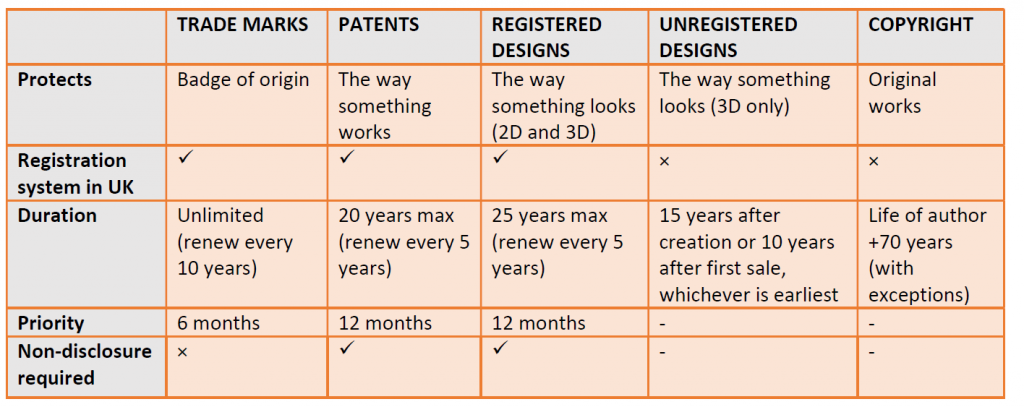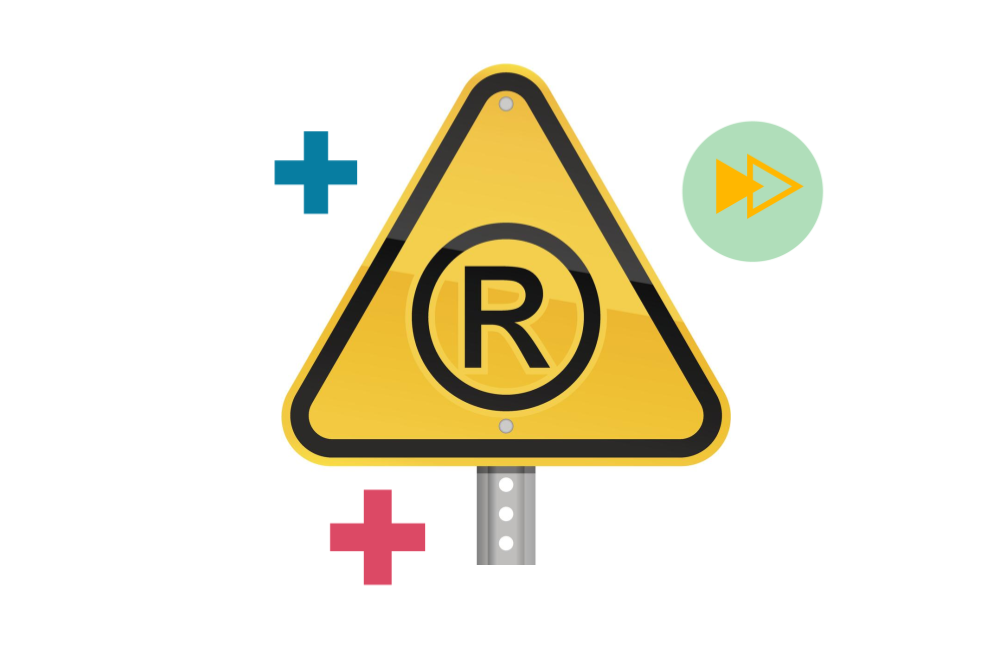
Author Matt Sammon
Intellectual Property (IP) is everywhere – you can find it in your branding, your creations, your innovations and your products. The legal protection of intellectual property rights is split into four main categories: trade marks, patents, designs and copyright. The purpose of intellectual property is to encourage commerce and innovation by offering a method of protecting your identity and anything that you create.
But Intellectual Property can be a minefield of terminology and legalese. It’s a common misconception that you can obtain a patent for your trade mark, or that you can only enjoy copyright in something that has artistic merit. Here we guide you through how to identify your IP rights, and how to identify the correct legal protection, which in some cases may be multiple forms.
Identify what IP rights may exist
It is not possible to protect an idea or concept. It is only possible to protect the physical manifestation of that idea or concept. If you are only at the ideas stage, you will not be able to obtain any legal protection. That idea must be represented in a physical form, be that a product, an image, a logo, a poem etc. before you can enjoy the benefits of legal protection.
Once you understand the key differences between the four main types of intellectual property, and can distinguish between them, it becomes easier to identify which IP rights are relevant to you, and to understand how to exploit that IP right to your advantage. The key question to ask yourself is, what feature am I trying to protect?

Your product or service may attract a combination of protectable IP rights, some of which may surprise you. Your IP advisor will be able to discuss this with you in more detail, and will be able to provide recommendations for the most suitable or relevant type of IP for you. If you are yet to appoint an IP specialist for your brand please read our guidance on how to choose the best IP law firm for your brand.
Subsistence of IP rights
In order to attract the protection afforded by IP, your product or other work must first meet essential criteria. Failure to meet these essential criteria will render your product or work incapable of IP protection.
In each case, there are express restrictions on what can or cannot be protected, and your IP advisor will be able to discuss these restrictions with you. Below are key examples of the criteria for each type of intellectual property.
(i) Trade Marks
- The chosen trade mark must have some distinctive character which establishes the sign as an indicator of origin rather than just a laudatory expression
- The chosen trade mark must not exclusively describe a characteristic or feature of the goods or services in relation to which protection is sought
- The chosen trade mark must be sufficiently different from previously existing trade marks in the same commercial sector to avoid confusion
(ii) Patents
- The invention must be novel compared to anything else already in the public domain. It is therefore essential that any conversations surrounding the invention are conducted under cover of a Non Disclosure Agreement (NDA) as prior disclosure will be fatal to an application
- The invention must have some technical effect and not just a visual or aesthetic effect
- The invention must not be an obvious modification of something already in existence
(iii) Registered Designs
- The design must be new compared to anything else already in the public domain, and therefore as with patents, prior disclosure of the design to the public will be fatal to an application
- The design must be sufficiently different from any previous designs in existence such that a different overall impression is created
- Protects 3D physical shape and configuration and also 2D designs, surface patterns and decoration, but does not protect technical function
(iv) Copyright
- The work must be original and have been independently created
- Copyright protection only exists in the physical manifestation of the work, and not in the idea of the work before it is fixed. for example, written down
- The work does not have to be visually appealing to attract copyright protection, which can for example, subsist in block text or building designs
The process of IP protection
Once you have identified your IP, you should seek the available legal protection for your intellectual property rights wherever possible in order to provide you with a strong basis upon which to stop unauthorised use of your property.
Protecting copyright and unregistered designs
In the UK, copyright and unregistered design right arise automatically, and there is no official register for those types of IP rights. As there is no official register, those rights are not subject to an official examination process, and they are therefore generally viewed as weaker, and more difficult to assert than registered rights.
Protecting trade marks, design and registered designs
Trade marks, patents and registered designs all have an official registration system during which the product or work is examined by an official body to determine its eligibility for legal protection against the official criteria.
Trade marks, patents and registered designs are all territorial in nature, meaning that securing protection in the UK alone will not provide you with any protected IP rights beyond the UK. There are various methods for obtaining protection which are available to you, depending upon the geographical scope of the protection that you require.
Intellectual Property rights by territory
If you are only interested in UK protection, then you can simply file your application before the UKIPO which will grant you UK rights, applicable only in the UK.
Alternatively, there are various different methods and systems that you can use to protect your IP further afield, all of which have different advantages and disadvantages, and cost implications. We recommend appointing an experienced Trade Mark Attorney who can deliver expert IP protection services in each territory that you need it and help you strategically plan for business growth.
Some systems offer unitary protection in a particular area, for example an EU Trade Mark Application filed at the European Union Intellectual Property Office (EUIPO) will grant you EU-wide protection under one registration. Note that following expiry of the Brexit transition period, the UK will no longer be covered by this EU-wide system. Further guidance on how Brexit will impact on your IP can be found in our BREXIP series of blogs.
Other systems offer the facility to pick and choose the countries that you cover from a wide list of member countries, for example an International Trade Mark Registration filed at the World Intellectual Property Organisation (WIPO) which effectively results in a bundle of national rights maintained via a central administrative office.
There are various priority systems available to applicants of trade marks, patents and registered designs. You can take advantage of these systems to spread the cost of international filing programmes, and to test the market before seeking protection. Please consult your IP advisor for further guidance in this area.
The benefits of legal protection
When legally protected, your IP rights will acquire concrete value for your enterprise as they cannot be commercialized or used without your authorization. Obtaining legal protection for your IP rights essentially turns what is an intangible asset into a tangible one, creating a valuable, exclusive item of property that can be traded in the marketplace, licensed, bought and sold.
Enterprises are increasingly realizing the value of their IP assets, including them in accounts balance sheets. Investors and financial advisors are acknowledging the value of IP with increasingly high valuations. Depending upon their market sector, some enterprises are realizing that their protected IP is of higher value than any physical assets on their balance sheet. Some well-known brands even use their protected IP as a feature of their advertising, for example referencing the size of their patent portfolio in order to demonstrate the level of their innovation.
Type of IP and their key administrative features

We create real IP value
From the everyday to the IP emergency, our accomplished Chartered Trade Mark Attorneys and IP Solicitors are driven to get the very best outcome for every brief for every client, every time! Sonder & Clay are a full service IP law firm with proven expertise and results in IP protection, strategy, disputes, and exploitation. Learn more about our IP services or get in touch with us for a complimentary IP audit today.


